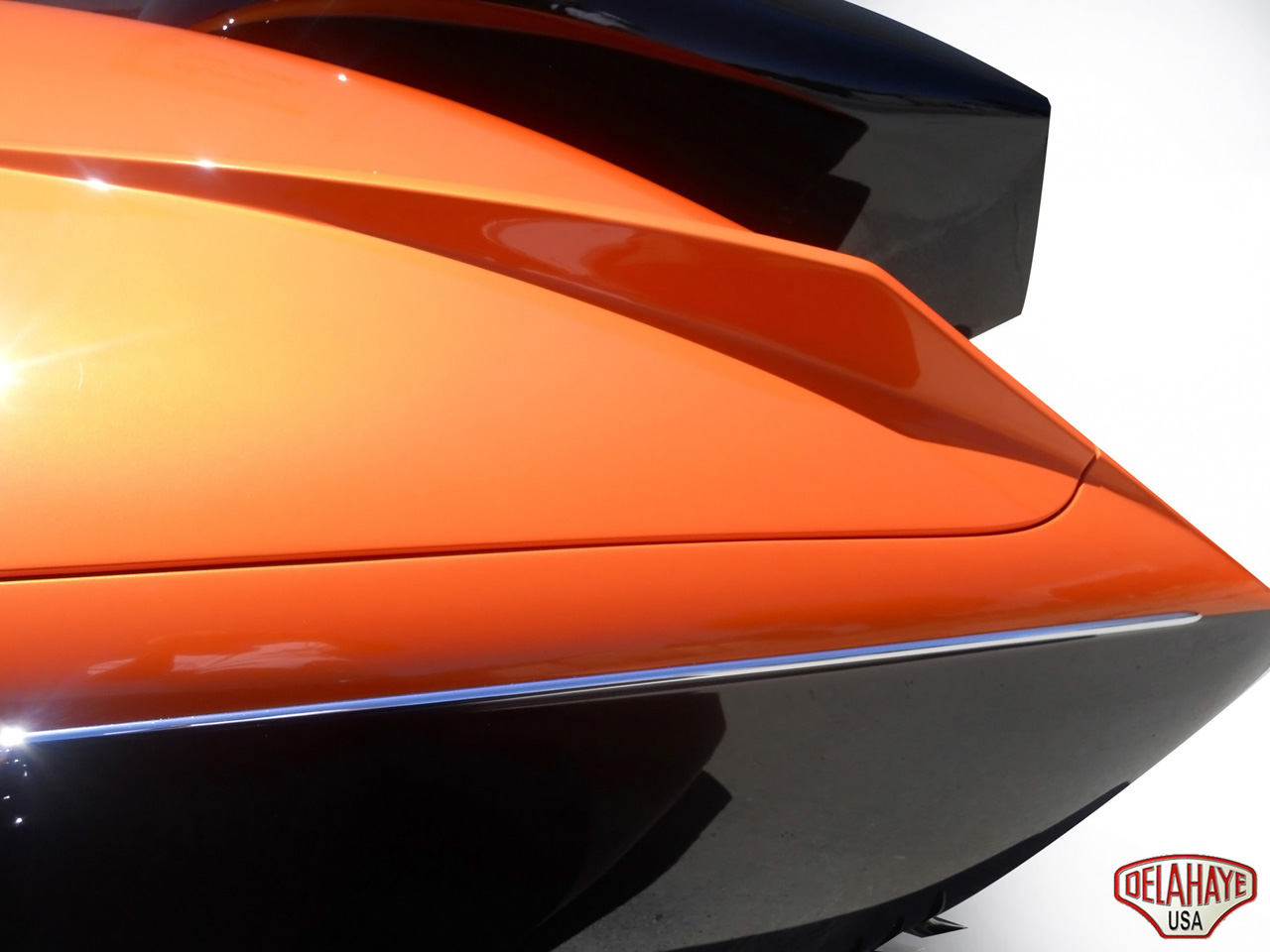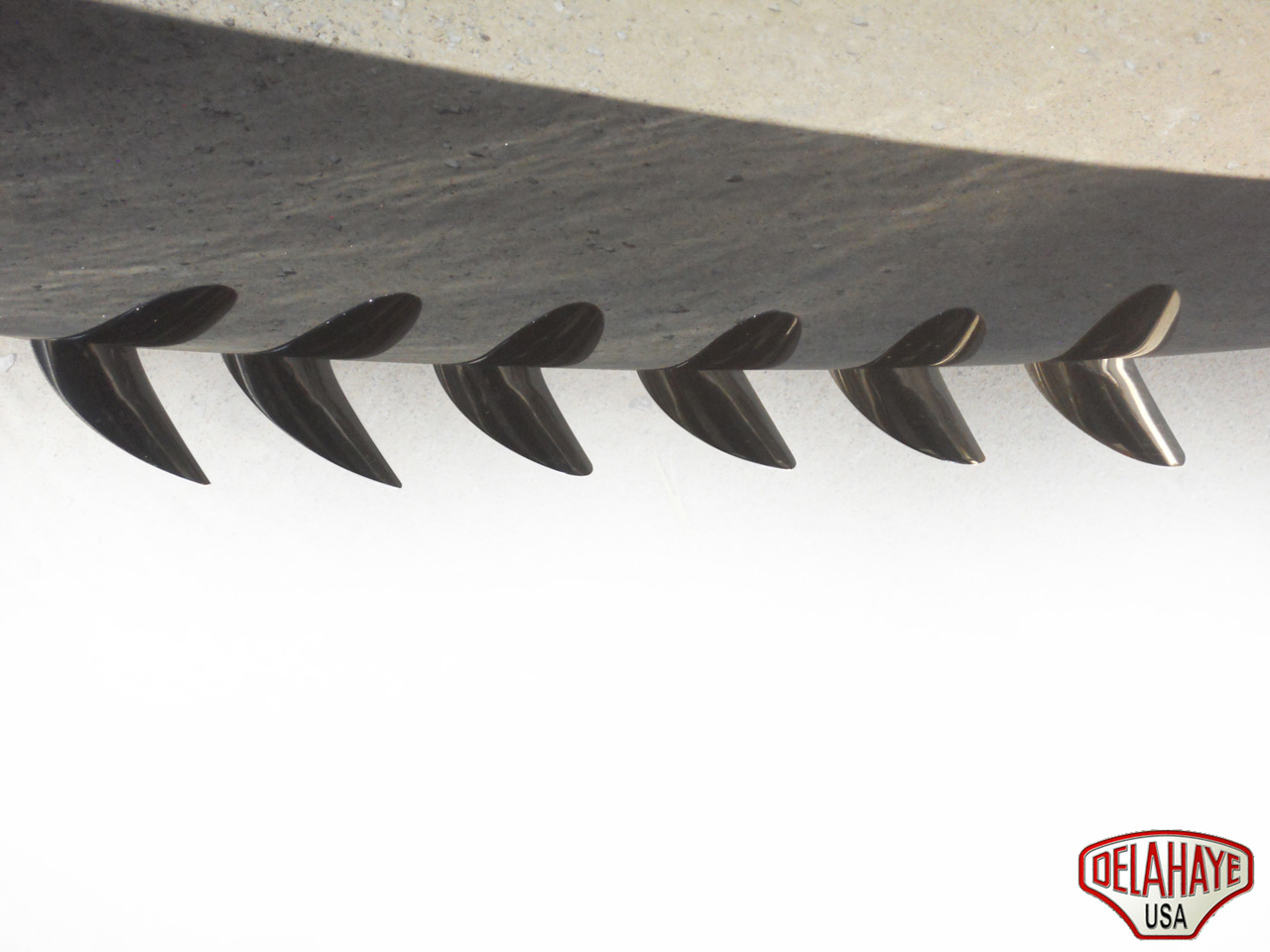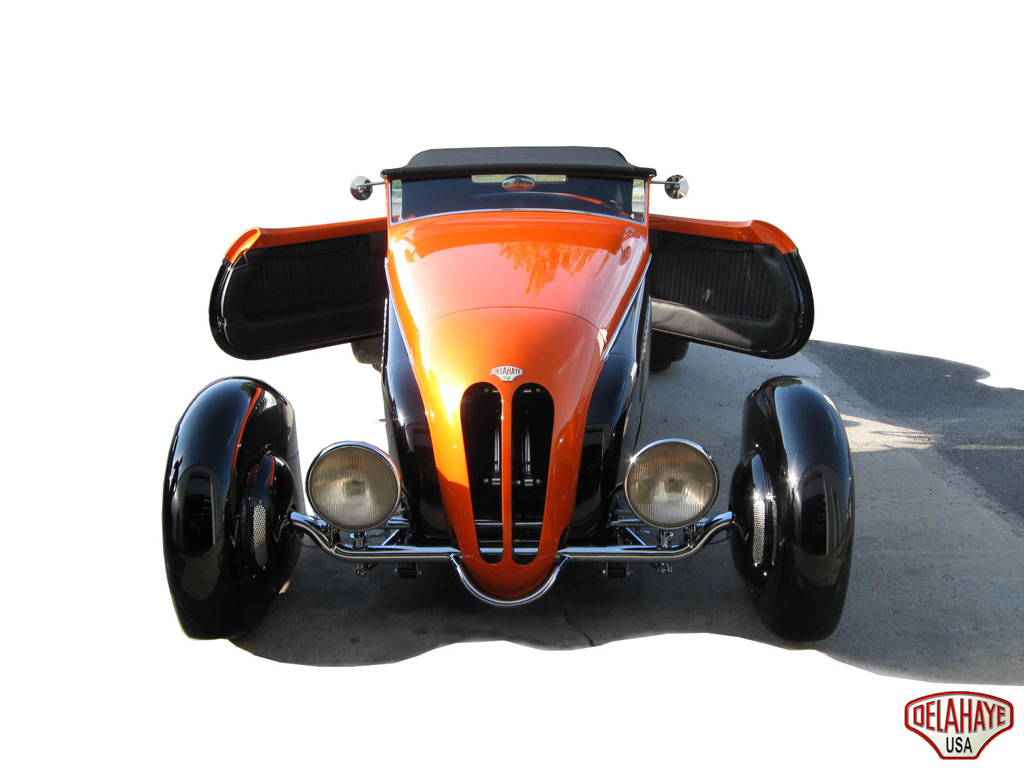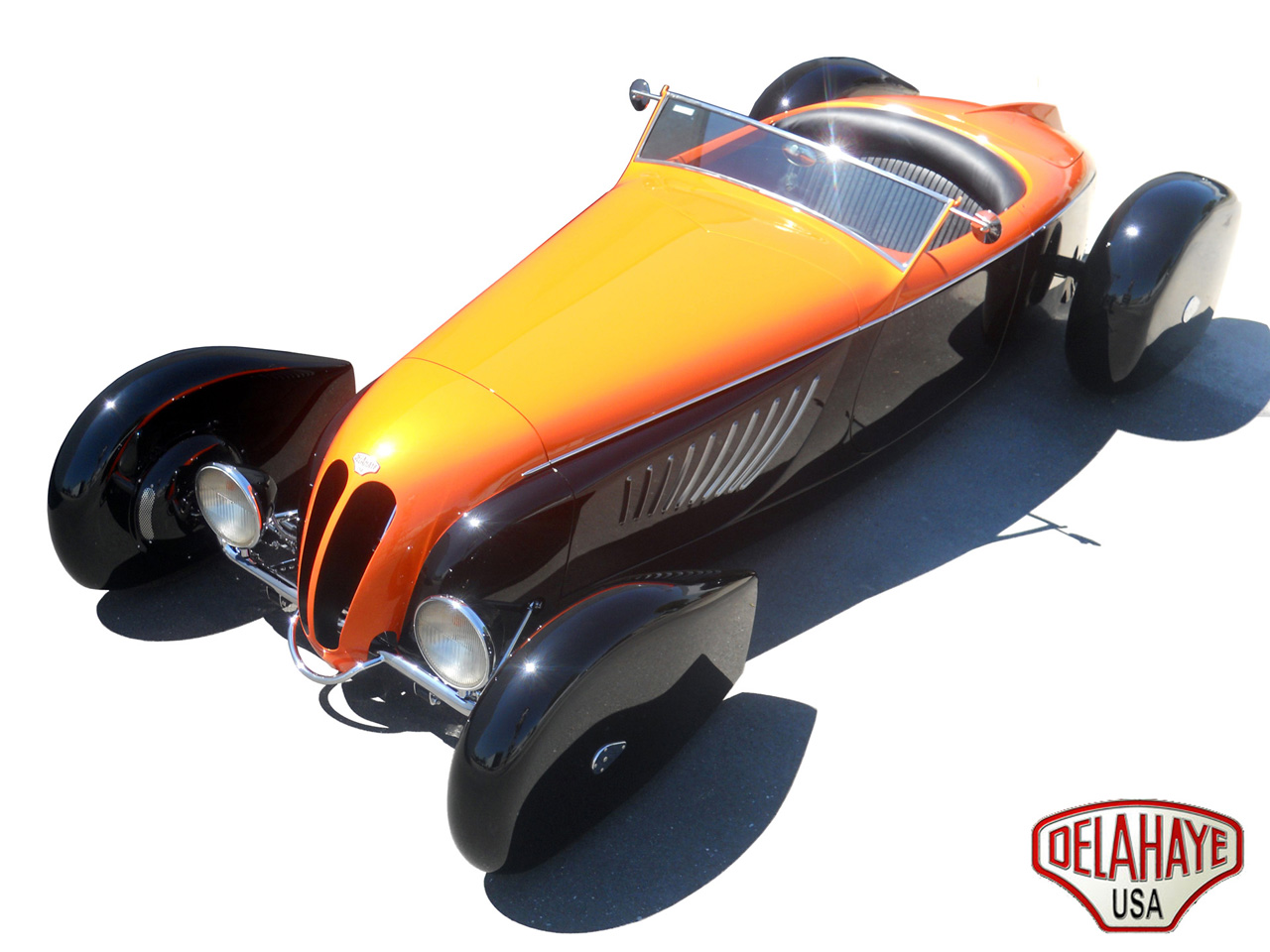2011 Delahaye USA Lockhart Boattail
|
Price |
-- |
Production |
-- | ||
|
Engine |
4.6 liter Ford Mustang V8 |
Weight |
-- | ||
|
Aspiration |
-- |
Torque |
-- | ||
|
HP |
-- |
HP/Weight |
-- | ||
|
HP/Liter |
-- |
1/4 mile |
-- | ||
|
0-62 mph |
-- |
Top Speed |
-- |
(from Delahaye USA
Press Release) LOCKHART INSPIRED BOATTAIL SPEEDSTER
The black and orange Frank Lockhart STUTZ |BLACK HAWK inspired
boattail is the fifth in a series of speedster creations by TERRY
COOK of Long Valley, NJ utilizing his DECO RIDES body as the basis
of the car. Several years ago Terry saw a red scale model of a
boattail streamliner built and designed by Mike Ball of VELOCITY
ENGINEERING in Fort Wayne, IN. Ball had been inspired by the famed
Lockhart land speed record attempt car from 1929. When Terry saw
Mike’s red model, it in turn inspired him to build this car, which
is distinguished by four pontoons cloaking the wheels.
Built over a period of several years, the car was constructed by
Gary and Dillon Brown at BROWNS METAL MODS in Indianapolis, IN.
Ironically this is the same town where the original STUTZ BLACK HAWK
was built in the late 1920’s. Starting with a fiberglass body at FAT
MAN FABRICATIONS in Mint Hill, NC, Mike “Bubba” Craig and Brent Van
DerVoort fashioned a custom 130 inch wheelbase frame that featured a
“suicide” style tube front axle suspended by a pair of quarter
elliptic springs, The goal was to position the front axle out in
front of the nose and enclose the Radiir 18 x 3 12-spoke spindle
mount front wheels with small Hearst spot disc brakes within a pair
of slim fiberglass streamlined wheel pants which DECO RIDES also
manufactures. The shape of the trailing edge of these small pontoons
was changed to emulate the design of those on Frank Lockhart’s car.
Not only do the front wheel pants swivel and turn with the car’s
steering, the headlights turn with the steering as well. A small set
of aluminum “pie plates” with a screened mesh opening to both cloak
and cool the spot brakes were fashioned by panel beater Denny
Jamison of AUTOMOTIVE HAMMER ART on Gasoline Alley in Indy. He also
built the aluminum rear pontoons that mount directly to the rear
axle housing. Because you can’t see the wheels or tires, when the
car is move, it appears to be levitating or floating above the
ground!
The custom nose, hood and side panels were hand fabricated from
steel by Gary Brown, and the side panels feature unique reverse cut
sweeping curved louvers by metal shaper Rex Rogers of CUSTOM AUTO in
Loveland, CO. Most people take the louvers for granted, but have you
ever seen reverse curved louvers anywhere on any car in history?
Plotting out the pattern for the louvers required a flotilla of
e-mails between Cook and Rogers to arrive at the final layout,
followed by a challenge of extreme dexterity by Rex to achieve the
final result. Thanks must go to noted car illustrator/artist Darrell
Mayabb of Arvada, CO, Art Center grad John Caswell of Detroit and
veteran custom painter Don “The Egyptian” Boeke of Dayton, OH for
their “two cents” worth of opinion and input advising Cook on the
design of this project. One aspect where that particularly applies
is the shape of the small dorsal fin on the decklid. The custom
taillights in the trailing edge of the rear pontoons were hand hewn
from red plexiglass stock.
The engine in the House of Kolor Tangello orange pearl and black
boattail is a 4.6 litre Mustang V8. Because Cook likes to
incorporate humor in his creations, a set of chrome plated Ferrari
V-12 valve covers sit atop the engine cloaking the Ford single
overhead cam engine. Cook jokingly explains to people that it is a
rare “FORDRARRI” engine. Another name for the engine is FRORD (i.e.
“Fraud”). Twelve stainless exhaust pipes peek out from under the
boattail in keeping with the V-12 joke. The automatic transmission
is a 41279W Ford overdrive. Another touch of Cook’s constant desire
to have fun with his cars is the rubber Jivaro shrunken head hanging
from the rear view mirror.
The interior of the car was done in black tuck n’ roll leather by
Mike and Gary Griffey of Muncie, IN, who also fashioned the black
Hartz cloth top over a Dick Rodwell metal frame that was fabricated
to final shape by Gary Brown. The rear window is a LeBarron Bonney
item. Rodwell also supplied the subtly curved Stanley Wanlass
windshield, and Brown custom built the smooth A-posts that hold it
in place. The side spears were chrome plated by FINISHING TOUCH in
Chicago and the front end by SHERM’s CUSTOM PLATING in Sacramento,
CA.
The car debuted at the Louisville Street Rod Nationals, followed by
appearances at the Quail: A Motorsports gathering as a tow vehicle
for the Bella Figura Type 57S, at the Rolex Laguna Seca Vintage
Races and the Pleasanton Goodguys event. Wherever it appeared, it
attracted a crowd and a bevy of photographers. The car is presently
FOR SALE to make room in the garage for Cook’s next creation.
Interested parties can contact
terry@decorides.com.
A tribute to FRANK LOCKHART
Frank Lockhart (5 March,
1903-April 25, 1928) Born in Dayton, OH, he was considered by many
as the greatest racing driver ever. In 1923 at the age of 20, he won
regularly at local California “outlaw” tracks including the newly
opened Ascot dirt track in his modified Model T Ford. His reputation
earned him a ride in Harry Miller’s 3.0 liter dirt racer. At 23, he
won the 1926 Indy 500 in his first year there and was on his way to
a second straight win in 1927 after grabbing the pole position with
a new record of 120 and leading the race through lap 110 when he
broke a rod. In May of 1927 he set a qualifying record of 147.729
with his supercharged 1.5 liter Miller at the Atlantic City board
track. It wasn’t until 1960 that another American superspeedway
driver would register a faster lap time. That same year he set a
world record of 164.28 mph on the Muroc dry lakes in a car powered
by a tiny 91.5 cu. in. engine.
By autumn he wanted the land speed record and convinced car
manufacturer Harry Stutz to build LSR special with twin Miller
straight eight power plants. With twin superchargers, the 3 liter
V-16 produced more than 550 HP at 8,300 rpm. Wind tunnel tests
projected the 2,700 pound car could exceed 280 mph! Called the STUTZ
BLACK HAWK, the elegant little silver and white streamliner was a
fraction of the size of the giant multi airplane engine land speed
cars of the era. During a trial run at Daytona Beach on Feb. 22,
1928 at a speed of 225, the tire struck an irregularity and
catapulted the car into the sea. Lockhart was unhurt and the car was
rebuilt in Indy and sent back to Daytona in April 1928 for another
attempt on the 123 to 183 cubic inch record. On April 25, 1928 he
shattered the record with a run of 198.29, a record that stood for
39 years. On the return run to break the 200 mph barrier, something
cut a tire and the car crashed killing the 25 year old racing
legend. Terry Cook was inspired to build this boattail with steering
“pontoonlettes” on the front wheels as a tribute to Frank Lockhart.



